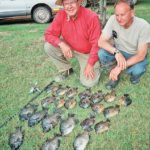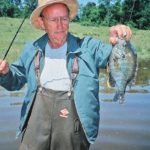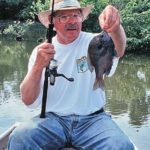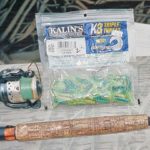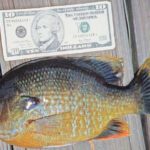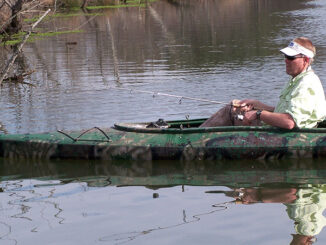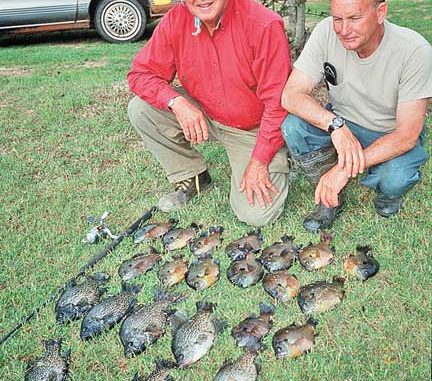
Try these five tricks and fill your stringer with bream every time out.
Certain fish are usually targeted by a particular group of anglers. It becomes normal for certain people to fish for stripers, catfish or bass.
Not so with bream, the common name that fishermen use to cover a variety of sunfish: bluegill, shellcrackers, pumpkinseeds, green sunfish and redbreasts.
Devotees to the art of bream-fishing cover the spectrum from toddlers all the way to senior citizens. Each of them have their own favorite ways to fish for this tasty morsel, and they all produce some level of success. Some work better than others, according to the expertise of the fisherman involved.
Most, however, are practiced with an eye on the times when bream are spawning in the shallows, often within sight of fishermen, and always with an eye on protecting their young ’uns.
In South Carolina, bream usually start bedding the first full moon in May each year. However, some bed as early as March in years when the spring is particularly warm. The bedding process takes place on the full moon each month on up until August.
Bream beds look like a honeycomb comprised of a number of plate-sized depressions. The males make these beds so females will come in and use them to lay their eggs. As soon as the females deposit their eggs, they vacate the vicinity. Males immediately come in to guard the beds against predators such as minnows and other fish that eat the eggs. It’s the males’ job to look after the nest and keep it free of debris and silt, and he works hard as he circles the bed religiously, keeping it clean. It is at this time that bream are the easiest to catch.
When fishing a bream bed, start at the edge as opposed to the middle; this lessens the chance of spooking other fish away. When the bite ceases on one set of beds, move on to another. Return to the first beds an hour or so later, and you can usually catch additional fish.
Novice and veteran anglers can still learn from five time-tested methods for putting nice bream on a stringer.
THE DROP SHOT
This type of fishing is common when anglers are targeting crappie and bass, and it’s very effective for catching bream, too. When drop-shotting, an angler can use one or more hooks. An easy method when using multiple hooks is to thread the hooks onto the line and clamp a split shot near the end. Slide the hook nearest the split shot up the line six to 10 inches and make a finger-length loop, letting the hook dangle at the end of the loop. Tie a double overhand knot by running the loop through the circle in the line two times. Snug the knot down; this lets the hook dangle free at the end of the loop. Repeat this procedure for additional hooks, and space the hooks 18 inches apart. This method can be used to fish “dead line” on the bottom, or it can be used with a float.
HOOK-AND-SHOT
The hook-and-shot method primarily is used for fishing on the bottom. Tie a No. 4, 6 or 8 Eagle Claw hook on the end of your line using a clinch knot. Clamp on a split shot 12 inches above the hook. Cast and reel in the slack, waiting for a strike, which will feel like a slight bump — like someone tapped the line with a pencil.
HOOK-SHOT-AND-FLOAT
A hook-and-shot with a float is used when you want your bait at a certain depth. Rig the same way as the hook-and-shot and add as small a float as you can that will buoy the weight it has to carry; this will make subtle strikes easier to see. Set the hook when the float goes under or is pulled through the water at a steady pace.
Numerous types of floats are available. Some fishermen prefer to use a long, slim float that attaches on one end with a spring. A very small split shot is used, so the float lays on its side. The float stands up when a fish bites.
BUG-AND-FLY
The bug-and-fly method can be used with a fly rod or with spinning gear. When using a fly rod, tie a small popping bug to your line using a clinch knot. Tie an 18-inch leader to the bend in the popping bug’s hook with a clinch knot; tie a black gnat to the other end of the leader using another clinch knot. Strikes on the popper will be visual; strikes on the fly will cause the popper to jump or be pulled under.
To bug-and-fly with spinning gear, a casting float is needed to give additional weight to make casting easier. Tie the teardrop-shaped casting float to the terminal end of your line; tie an 18-inch leader to one end of the casting float, and to the eye of the popper on the other using clinch knots. This system allows you to cast lightweight lures much more easily.
CAST-AND-RETRIEVE
This method is primarily used with artificial lures, but it can be adapted to use with live bait. When fishing artificials, tie the lure directly into the line using a clinch knot.
There are several ways to fish this method, the most common being casting and making a steady retrieve. An irregular retrieve, twitching the rod tip, or letting the lure flutter down for one or two seconds every three turns of the reel handle is an alternative. Letting the lure fall to the bottom before starting the retrieve is another.
Your success rate of catching jumbo bream can climb like a space ship when you use a tactic that Norman Ledford Jr., of York developed. Ledford uses Kalin’s 2-inch, 3-color crappie jigs on an eighth-ounce jighead. Using a slow retrieve seems to work best. When you feel a slight bump, set the hook and enjoy the fight.
Another version is to tie two crappie jigs in tandem 12 to 18 inches apart. By using two jigs of different colors, bream have a choice of colors; catching a double is fairly common.
A third version is to tip a jighead with a piece of earthworm to add scent to the offering. That’s a trick that Dr. Bob Martin of Fort Mill came up with. This can be taken one step further by using only the jighead, and threading a half an earthworm on the hook, leaving one end dangling; this combination can be used with a regular slow retrieve or fished on the bottom. A float can be used above the jig if a controlled depth is desired. When the bite slows, sometimes a twitching retrieve can stimulate bream to strike.

